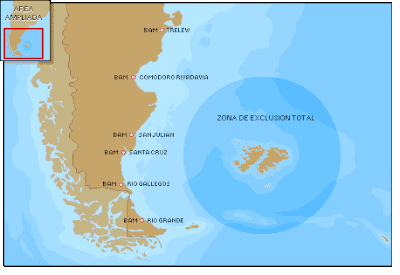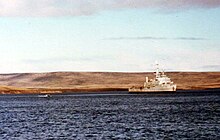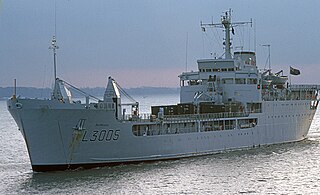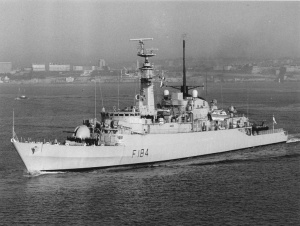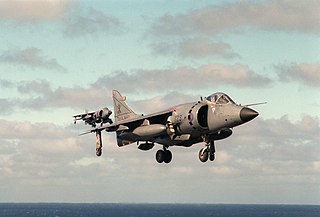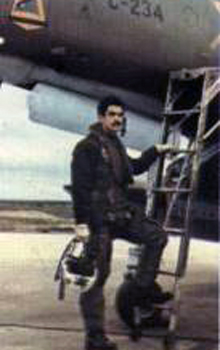| List of Sorties |
|---|
| Time | Branch | Aircraft | Callsign | Pilot(s) | Summary |
|---|
| 21 May |
| 10:15 | COAN | MB339 | 4-A-115 | Lt Guillermo Owen Crippa | A reconnaissance flight flew over the landing force twice to determine the exact composition of the fleet, earning the highest national military decoration, the Argentine Nation to the Heroic Valour in Combat Cross. He attacked HMS Argonaut and an unidentified RFA ship with guns and rockets, then withdrew. |
| 10:15 | FAA | Pucara | Tigre | Cpt Benítez
Mj Tomba
1st Lt Micheloud | Three (of four) planes scrambled from Goose Green and were engaged by gunfire from HMS Ardent. Cpt Benítez was shot down by a Stinger missile fired by the Special Air Service; he ejected and walked back to his base, arriving at 19:00. The other two pilots, Mj Tomba and 1st Lt Micheloud, fired 2.75-inch rockets at a shed apparently used by British forces as an observation post destroying their target, but were intercepted by two Sea Harriers during their escape. Mj Tomba was shot down (ejecting safely) by pilot Nigel Ward, [19] while Lt Micheloud's aircraft escaped and landed at Port Stanley's airfield. |
| 10:20 | FAA | MIIIEA | | | Four aircraft made a diversion north of the islands. |
| 10:25 | FAA | Dagger | Leon | Cpt Dimeglio
Lt Castillo | From San Julian, Cpt Dimeglio and Lt Castillo attacked HMS Antrim with their 30mm cannon. Their 1,000 lb (450 kg) bombs failed to explode. |
| 10:30 | FAA | Dagger | Ñandú | Cpt Rodhe
Lt Bean | From Rio Grande, Tierra del Fuego, Cpt Rodhe and Lt Bean attacked HMS Argonaut, Lt Bean was shot down by a Sea Wolf SAM from HMS Broadsword; Broadsword was attacked by pilot Cpt Janet. |
| 10:35 | FAA | Dagger | Zorro | Cpt Dellepine
Cpt Diaz
Cpt Aguirre-Faget | Cpt Dellepine, Cpt Diaz and Cpt Aguirre-Faget bombed and strafed HMS Brilliant but the bombs hang-up. |
| 10:50 | FAA | Dagger | Perro | Mj Martinez
Cpt Moreno
Lt Volponi | Mj Martinez, Cpt Moreno and Lt Volponi attacked HMS Antrim. Their 1,000 lb (450 kg) bombs did not explode, but one of them hit the stern of the destroyer, which also received damage from 30 mm strafing. During their escape, Sea Harriers launched Sidewinders against the Daggers but the missiles fell short. |
| 12:45 | FAA | A-4C | Pato | Cpt Almoño
Cpt Garcia
1st Lt Daniel Manzotti
Lt Nestor Lopez | Intercepted by Sea Harriers; Manzotti and López were shot down and killed by Sidewinders. |
| 12:45 | FAA | A-4B | Mula | Cpt Carballo
Ensign Carmona | Mula 2 attacked an unknown ship, most probably the abandoned Argentine cargo vessel Rio Carcaraña, and withdrew, [20] Carballo continued alone and attacked HMS Ardent straddling her with two bombs, both of which failed to explode. [17] |
| 13:37 | FAA | A-4B | Leo | 1st Lt Filippini
Lt Autiero
Lt Osses
Lt Robledo
Ensign Vottero | Hit HMS Argonaut with 1,000 lb (450 kg) bombs which did not explode, with one crashing through her Sea Cat magazine, detonating two missiles and causing damage and two fatalities among Argonaut's crew. |
| 14:30 | FAA | MIIIEA | | | Two aircraft took off as a diversion. |
| 14:35 | FAA | Dagger | Cueca | Cpt Mir Gonzales
Cpt Robles
1st Lt Luna
Lt Bernhard. | Intercepted by Sea Harriers, and Lt Luna was hit by a Sidewinder but ejected safely. The other three pilots attacked HMS Ardent, and hit the warship with 30 mm gunfire and two 1,000 lb (450 kg) bombs on her stern before returning safely to their base. The frigate's Sea Lynx helicopter was destroyed. |
| 14:53 | FAA | Dagger | Laucha | Mj Puga
1st Lt Román | Attacked HMS Brilliant. The third pilot attacked an unknown ship, probably HMS Antrim. |
| 14:58 | FAA | Dagger | Raton | Mj Piuma
Cpt Donadille
1st lt Senn. | Intercepted by Sea Harriers of Nigel Ward and Lt Thomas. The Daggers dropped their ordnance −2 fuel tanks and one 1,000 lb (450 kg)- and tried to escape, but the three were shot down by Sidewinders, with all pilots ejecting safely. After recovering the pilots, the FAA realised that the San Julian-based Daggers' approach corridor had been discovered and made efforts to correct the situation. |
| 15:15 | COAN | A-4Q | Tabanos | Cpt Philipi
Lt Arca
Lt Marquez | Hit HMS Ardent with several 500 lb (230 kg) retarding tail bombs and cannon fire. Two aircraft were shot down by Sea Harriers during their escape, killing Lt Marcelo Márquez. Lt. Philippi ejected safely and, after being sheltered by local farmer Tony Blake during the night, [21] he rejoined the Argentine forces. The third A-4Q, Lt Arca, was damaged and the pilot bailed out into the sea approximately 800 to 1,000 meters off Cape Pembroke, Port Stanley. Arca was rescued from the water by Capt. Jorge "Picho" Svendsen's Huey UH-1H from the Army's 601 Helicopter Battalion. HMS Ardent sank in the morning of 22 May. Both crew were decorated with the Valour in Combat Medal. |
| 17:02 | FAA | A-4C | | | No ships found. |
| 17:12 | FAA | A-4B | | | No ships found. |
| 23 May |
| 13:30 | FAA | A-4B | Nene | Carballo
1st Lt Guadagnini
Lt Rinke
Ensign Gomez | Attacked HMS Broadsword and HMS Antelope. Carballo's plane was damaged by a Sea Cat missile, fired from Antelope, during his bombing run, so he broke off the attack and returned to Rio Gallegos. A second Argentine plane dropped a 1,000 lb (450 kg) bomb on Antelopes starboard side, killing Crewman Mark R. Stephens. Lieutenant Guadagnini was hit and killed by HMS Antelope 's 20 mm cannon and crashed through her main mast while carrying out his bombing run; his bombs pierced the frigate's hull without exploding. [22] After the attack, one of these detonated while being defused, sinking the ship. |
| 13:45 | COAN | A-4Q | Tabanos | Cpt Castro Fox
Cpt Zubizarreta
Lt Benitez | Attacked HMS Broadsword, HMS Yarmouth and HMS Antelope without visible success. Cpt Carlos María Zubizarreta was killed in Rio Grande, Tierra del Fuego when his parachute did not fully open after he ejected from his A-4Q due to a tyre bursting on landing with his bombs still loaded. The plane stopped by itself and did not suffer any damage. [23] [24] |
| 15:10 | FAA | Dagger | Puñal | Mj Martinez
Lt Volponi | Intercepted by Sea Harriers, which shot down the second aircraft, whilst Martinez returned to base. |
| 15:10 | FAA | Dagger | Daga | | Struck targets inside Ajax Bay |
| 15:10 | FAA | Dagger | Coral | | Struck targets inside Ajax Bay |
| 24 May |
| 10:15 | FAA | A-4B | Chispa
Nene | Com Mariel
1st Lt Sanchez
Lt Roca
Lt Cervera
Ensign Moroni | Attacked ships inside the bay. RFA Sir Lancelot was hit by a 1,000 lb (450 kg) bomb, which did not explode. Two LCUs are also attacked. |
| 11:02 | FAA | Dagger | Azul | Cpt Mir Gonzalez
Cpt Maffeis
Cpt Robles
Lt Bernhardt | Attacked unidentified ships, probably RFA Sir Bedivere, inside the bay. |
| 11:07 | FAA | Dagger | Plata | Cpt Dellepiane
1st Lt Musso
Lt Callejo | Struck ground targets with 500 lb (230 kg) retarding tail bombs. |
| 11:08 | FAA | Dagger | Oro | Mj Puga
Cpt Diaz
1st Lt Castillo | Intercepted and shot down by Sea Harriers. Castillo was killed and the other two ejected safely. |
| 11:20 | FAA | A-4C | Halcon | Cpt Pierini
1st Lt Ureta
Lt Mendez | Intercepted by Sea Harriers but managed to return to base. |
| 11:30 | FAA | A-4C | Jaguar | 1st Lt Vazquez
Lt Bono
Ensign Martinez | Attacked unidentified ships, possibly RFA Sir Galahad, inside the bay. The three aircraft all received battle damage with Bono's aircraft crashing during the return flight. The other two Skyhawks were rescued by a KC-130 tanker, which approached the islands and delivered 30,000 litres of fuel while accompanying them to the airfield at San Julian. |
| 25 May |
| 09:00 | FAA | A-4B | Marte | Cpt Hugo Palaver
Lt Daniel Gálvez | Cpt Hugo Palaver's aircraft was damaged in a friendly fire incident when he and Lt Daniel Gálvez accidentally flew over Goose Green and strafed the pier there, in the belief that they were over Ajax Bay. [25] The main anti-aircraft artillery identified the fighters as friendly and did not fire, but soldiers on the ground engaged with small arms fire. [26] When they returned to the strait, Palaver was shot down by a Sea Dart missile fired by HMS Coventry |
| 12:25 | FAA | A-4C | Toro | Cpt Garcia
Lt Lucero
Lt Paredi
Ensign Issac | Attacked ships inside the bay, probably RFA Sir Lancelot. After the attack Lucero was shot down by the San Carlos air defences. He successfully ejected over the landing force, [27] was rescued and then transferred to the hospital ship SS Uganda. A Sea Dart, fired by HMS Coventry, shot down Garcia, whose aircraft had been damaged by small arms fire during the attack, to the North of San Carlos. Cpt Garcia ejected, but was not recovered and died. Ensign Isaac was losing fuel but was rescued by the KC-130, which accompanied him to his base while refuelling him in flight. |
| 15:20 | FAA | A-4B | Vulcano | Cpt Carballo
Lt Carlos Rinke | Attacked HMS Broadsword, picture from ship damaging the frigate's communication systems and hydraulics and electrics [28] and shattering the nose of her Sea Lynx helicopter Pictures of the Damage |
| 15:20 | FAA | A-4B | Zeus | 1st Lt Velasco
Ensign Barrionuevo | Attacked and sank destroyer HMS Coventry after hitting the ship with three 500 lb (230 kg) bombs. British video Argentine video |
|


